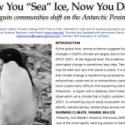
View The Resource
http://pal.lternet.edu/docs/outreach/educators/instructional_materials/Now%20You%20Sea%20Ice%20Now%20You%20Dont%205%20-%2020%20-%2013.pdf
http://pal.lternet.edu/docs/outreach/educators/instructional_materials/Now%20You%20Sea%20Ice%20Now%20You%20Dont%205%20-%2020%20-%2013.pdf
Time Required
3.5 hours or 5, 45-minutes class periods
3.5 hours or 5, 45-minutes class periods
Teaching Tips
Teachers might want to present a map of Antarctica and locate the regions discussed in the activity. This could be a case study for an ecology or global change unit in an upper level ecology course. The lesson would also be a good culminating activity allowing students to demonstrate their grasp of how various environmental factors influence each other and the possible effects.
Teachers might want to present a map of Antarctica and locate the regions discussed in the activity. This could be a case study for an ecology or global change unit in an upper level ecology course. The lesson would also be a good culminating activity allowing students to demonstrate their grasp of how various environmental factors influence each other and the possible effects.
About The Science
Very strong description of science content: population dynamics of three species of Antarctic penguins (Adelie, Gentoo and Chinstrap) and relevant climatic factors.
Very strong description of science content: population dynamics of three species of Antarctic penguins (Adelie, Gentoo and Chinstrap) and relevant climatic factors.
Pedagogy Annotation
Students use the jigsaw strategy (specialist, or expert, groups then form mixed groups to share and compare basic knowledge and different views about the larger system) to learn more about the complex issues. Each student assumes the role of an expert on specific content and join with different content experts to understand the issues. Groups consists of: Bird Ecologist, Oceanographer, Meteorologist, Biologist, Climatologist. Students plot, then analyze current numerical and graphical data to come to conclusions about the effect of global warming on populations of penguins. Then in their mixed groups, they construct a flowchart illustrating the various connections between abiotic factors and penguin survival. At the end, students answer open-ended inquiry questions. Activity has flexible structure, such that the units can be easily broken up into pre-classroom, classroom, and post-classroom activities as time requires. Activity is easy to follow. All required materials are included. Interesting and engaging student materials. Charismatic megafauna will grab students! Students may require basic knowledge about Antarctica and penguins before the activity. Links to references are provided to help the teacher prepare for the activity, or to further engage students with regional knowledge of the penguin population.The teacher can share the information or ask students to investigate several sources provided in the lesson.
Students use the jigsaw strategy (specialist, or expert, groups then form mixed groups to share and compare basic knowledge and different views about the larger system) to learn more about the complex issues. Each student assumes the role of an expert on specific content and join with different content experts to understand the issues. Groups consists of: Bird Ecologist, Oceanographer, Meteorologist, Biologist, Climatologist. Students plot, then analyze current numerical and graphical data to come to conclusions about the effect of global warming on populations of penguins. Then in their mixed groups, they construct a flowchart illustrating the various connections between abiotic factors and penguin survival. At the end, students answer open-ended inquiry questions. Activity has flexible structure, such that the units can be easily broken up into pre-classroom, classroom, and post-classroom activities as time requires. Activity is easy to follow. All required materials are included. Interesting and engaging student materials. Charismatic megafauna will grab students! Students may require basic knowledge about Antarctica and penguins before the activity. Links to references are provided to help the teacher prepare for the activity, or to further engage students with regional knowledge of the penguin population.The teacher can share the information or ask students to investigate several sources provided in the lesson.
Technical Details/Ease of Use
A very thorough and informative set of teacher background materials is supplied. All parts of the activity (background, student sheets, etc.) are included in the pdf. Easy to use.
A very thorough and informative set of teacher background materials is supplied. All parts of the activity (background, student sheets, etc.) are included in the pdf. Easy to use.










